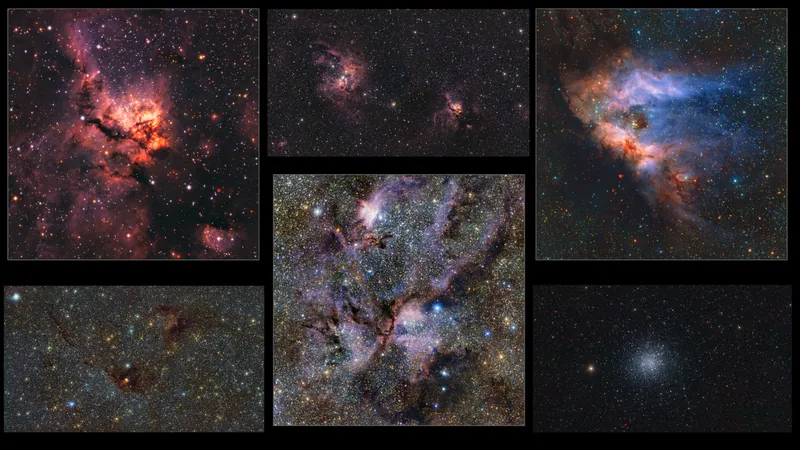
Milky Way Unveiled: Stunning New Map Shatters Records with 1.5 Billion Cosmic Objects!
2024-09-27
A groundbreaking achievement in astrophysics has emerged with the release of the most detailed infrared map of the Milky Way, showcasing a staggering 1.5 billion astronomical objects. This monumental feat was realized through the diligent efforts of the Visible and Infrared Survey Telescope for Astronomy (VISTA) stationed at the Paranal Observatory in Chile, which spent over 13 years, from 2010 to 2023, capturing an impressive 200,000 images. These images were compiled as part of the VISTA Variables in the Vía Láctea (VVV) survey, along with its extended counterpart, the VVV Extended Survey (VVVX).
To put this incredible achievement into perspective, the new map covers a sky area equivalent to 8,600 full moons seen from Earth, containing ten times more objects than a comparable map released in 2012 by the same research team. “We made so many discoveries that we have changed our view of the galaxy forever,” expressed project leader Dante Minniti, an astrophysicist at the Universidad Andrés Bello.
The success of VISTA lies in its powerful infrared camera, VIRCAM, which adeptly penetrated the dust and gas clouds that cloak many regions of our galaxy. This capability allowed scientists to view previously hidden locations, uncovering a rich tapestry of cosmic structures and phenomena.
What Secrets Lurk in the VISTA Milky Way Map?
The newly detailed map unveils a plethora of galactic wonders, including vibrant star-forming regions rich with nascent stars swaddled in gas and dust. Among these is the stunning NGC 6357, or the "Lobster Nebula," located approximately 5,900 light-years away in the constellation Scorpius.
Another remarkable area of interest is Messier 17, also known as the "Omega Nebula." Situated around 6,000 light-years from Earth in Sagittarius, this star-forming cloud measures roughly 15 light-years wide, part of a much larger structure approximately 40 light-years across.
Moreover, the dual nebulas of NGC 3603 and NGC 3576—otherwise known as the "Statue of Liberty Nebula"—are filled with newly forged stars, with NGC 3603 being one of the most massive young star clusters in the Milky Way, located around 20,000 and 9,000 light-years away, respectively.
In addition to these lively star factories, the map also features ancient stars found in globular clusters, dense groups of stars believed to have formed from the same primordial gas and dust clouds. Notably, Messier 22, or NGC 6656, a globular cluster situated about 10,000 light-years away, is a prime example of these ancient celestial assemblies. This cluster houses some of the galaxy's oldest stars, along with two stellar-mass black holes and six rogue planets that drift outside any star's orbit.
In a surprising twist, Messier 22 is one of only four globular clusters known to possess a planetary nebula, which consists of the remnants of massive stars that have ended their life cycles in spectacular supernova explosions.
Over the course of 420 nights, VISTA meticulously revisited the same patch of sky, enabling astronomers to pinpoint the locations of countless objects, track their movements, and monitor alterations in their brightness over time. This comprehensive examination provided a new perspective of our galaxy while giving rise to a revolutionary three-dimensional representation of the Milky Way.
Roberto Saito, an astrophysicist at the Universidade Federal de Santa Catarina in Brazil, stated, “The project was a monumental effort, made possible by a great team surrounding us.” This collaborative dedication has not just enriched our understanding of the Milky Way but also paved the way for future cosmic explorations.
Stay tuned, as the revelations from this record-breaking map continue to unfold, potentially redefining our cosmic frontiers!



 Brasil (PT)
Brasil (PT)
 Canada (EN)
Canada (EN)
 Chile (ES)
Chile (ES)
 España (ES)
España (ES)
 France (FR)
France (FR)
 Hong Kong (EN)
Hong Kong (EN)
 Italia (IT)
Italia (IT)
 日本 (JA)
日本 (JA)
 Magyarország (HU)
Magyarország (HU)
 Norge (NO)
Norge (NO)
 Polska (PL)
Polska (PL)
 Schweiz (DE)
Schweiz (DE)
 Singapore (EN)
Singapore (EN)
 Sverige (SV)
Sverige (SV)
 Suomi (FI)
Suomi (FI)
 Türkiye (TR)
Türkiye (TR)